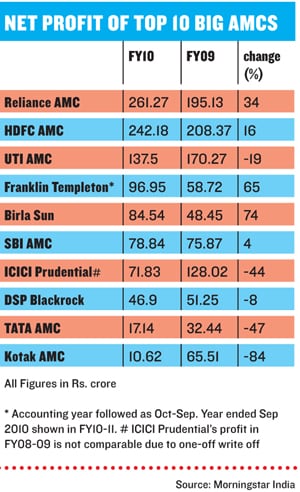Lessons From Fidelity’s Slip-Ups
Foreign funds wanting a foothold in the Indian mutual fund market should tie up with local distribution partners and explore new territory


Fidelity Mutual Fund, a global fund managing assets worth $310 billion, has decided to exit its India operations. This comes as a shock to many industry analysts as its MD and country head Ashu Suyash had single-handedly defied the mutual fund industry by not choosing the traditional channels of distribution and yet managed to build a good reputation for the fund in a span of just seven years.
Apart from being the only woman at the top in the mutual fund industry, Suyash also happens to be one of the most ambitious business leaders. She was not really well-known when Fidelity, the second biggest fund house in the world (next only to Vanguard), hired her as the country head for its India operations in 2005.
In May 2010, she stated that she wanted to put Fidelity India among the top five mutual funds in the country. The fund was then ranked number 20 with assets worth Rs 7,400 crore. Within 18 months, the fund saw its assets move up 18 percent while all the top funds saw a fall. Overall, the industry fell by 25 percent.
But now, Fidelity plans to exit its India operations as it has accumulated losses of Rs 300 crore and the overall return on investment for the fund has not been sustainable. Mutual fund analysts feel that the real reason is not clear as the Rs 300 crore-loss for a seven-year fund, with the backing of an international giant like Fidelity, is actually not very high. Fidelity’s exit will, however, leaves a big blot on the industry as other international funds who want to enter the Indian market will rethink their decision.
Over the last three years, the Indian mutual fund industry has virtually stagnated and has grown only by around 5 percent annually. Much of this growth has happened in the fixed income assets which normally comprise low-margin products. So, even if there has been growth in assets, the same is not happening with the bottomline of the asset management companies (AMCs). Fidelity and other foreign funds would have ideally been able to ride all the issues had they not compromised on costs, distribution and operational freedom. Fidelity India declined to comment on this story.
Cost Management
When Suyash was appointed to head Fidelity India, she decided to concentrate on equity assets that are considered to be profitable. Almost 70 percent of Fidelity’s assets are in equity, but recently the fund has also been looking at fixed income. Fidelity saw its business development expenses double over the last year as it was spending heavily on low-margin products.
The fund was also spending a lot on employees. Salaries of foreign funds operating in India need to be aligned with their international counterparts where employees are paid twice the amount compared with domestic funds.
Of its total expenses, Fidelity was spending half on employee salary and benefits. This is way above the 20-25 percent that Indian funds spend.
“Foreign players have higher costs. They pay higher salaries, and in most cases, they do not have a local in-house distribution agency which can promote their schemes. Domestic mutual funds are very cost conscious about the same,” says Nipun Mehta, a private banker who specialises in mutual funds.Most domestic players also have strong affiliation to national distributors or they have their own distribution companies. This is not the case with foreign players. They try to sell their products through international banks—their global tie-ups—that are operational in India. Globally, banks are the biggest distribution channels for mutual funds. Foreign funds feel that whatever has worked in international markets will also work in India.
In India, foreign banks account for almost one-third of the overall distribution market. However, due to competition from private Indian banks like ICICI and HDFC, the foreign banks are losing their market share. Indian mutual funds use banks, independent financial advisors (IFAs) and national distributors, like Bajaj Capital, as their main channels for distribution.
According to a McKinsey study released last October, it is the IFAs and national distributors who have witnessed the majority of growth over the last two years. But many foreign funds like Fidelity have stayed away from these channels and, thus, were not able to scale up.
Foreign funds that are new entrants into the market are now beginning to realise that tying up with local partners who understand distribution in a country like India is the key to their survival.
In India, metros and tier 1 cities account for 80 percent of the assets of the mutual fund industry. While foreign funds are not exploring new territory, domestic funds realise that tier 2 and tier 3 cities hold the potential for the bulk of their growth. Furthermore, in smaller towns, Indians are more comfortable with domestic brands.
Another reason why Indian funds are doing better than foreign funds is that they do not take much time to react to market situations, especially when it comes to new product launches.
It takes about six weeks for an Indian fund to launch a new product. For a foreign fund, this can extend beyond a year because of various processes and approvals from the global headquarters.
Freedom of Operations
The last, but not the least part, is the performance of fund houses. Foreign fund managers have to adhere to international philosophies when it comes to fund management. Often, these do not allow fund managers to pick and choose stocks to beat the markets. They have to stick to the rules dictated by the global headquarters. This is not the case with domestic fund houses. Most domestic fund houses allow fund managers to be flexible and invest heavily in mid- and small-cap segments.
“Investment processes of wholly or dominantly MNC-owned AMCs are quite inflexible. Domestic fund houses, in comparison, appear to be flexible in their choice of mid-cap and small-cap stocks within the framework of the guidelines laid down for the schemes. This often helps in better performance of select schemes,” says Mehta.
First Published: Mar 06, 2012, 06:29
Subscribe Now